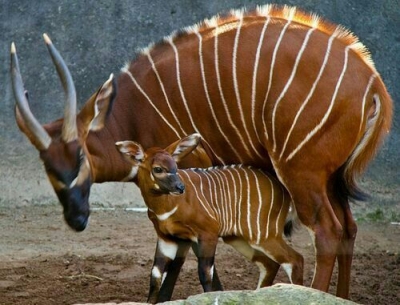
The bongo is also known as the lowland bongo or mountain bongo. It is a species of antelope. These animals are native to Africa. These are the heaviest and the biggest forest antelopes found only in Africa. The antelope species is easily recognizable among other wildlife of their kind for the vertical white stripes on their bodies. Both the male and female animals have a chestnut-orange coat and long horns. These bongo antelopes are the only horned species in the world where both sexes have long, wavy, horns. These colorful animals with big eyes, large ears, almost three feet high horns, and several vertical stripes on their body are the third largest among all species of antelopes. All bongo animals are nocturnal, shy, and mysterious wildlife that are rarely seen in the open. The number of bongos in the wild is decreasing rapidly and conservation efforts are underway. . Bongos can live up to 19 years in the wild. Bongos can run at the speed of 43 mph (69 kph). Bongos are the biggest forest antelopes and are quite heavy. The males weigh from 485 – 893 lb (220–405 kg) and the females weigh from 331 –518 lb (150-234 kg). Bongos are herbivorous animals and only include plant matter in their diet like leaves, bark, grass, roots, fruits, grains. These night-browsing animals get their nutrition from what they eat. Moreover, their nocturnal grazing habit keeps them safe from many predators sharing the same habitat.
Bongos are mammals. Female gives birth to only one calf at a time .There are fewer than a hundred mountain bongos left in the highland forests of Kenya, Africa. These animals are protected in Kenya to save them from extinction. The population of the lowland bongo are also decreasing in Western African countries. These animals have steady populations in their range in Central Africa. It is estimated that 28,000 bongos are left on earth. Loss of habitat and hunting are the two biggest threats to these antelopes.
Like most antelopes, bongos are rarely seen in bigger groups. Males are called bulls and roam around solitarily. Females live with the young in small groups of six to ten. A bongo herd usually never crosses more than twenty members. It is believed that the large ears of these animals aid in hearing the slightest noises. These animals recognize each other with their coloration in the dark forest habitat. These forest antelopes do not have any special secretion glands. They depend less on scents to find others of their kind in the forests.
Credit : Kidadl
Picture Credit :Google




